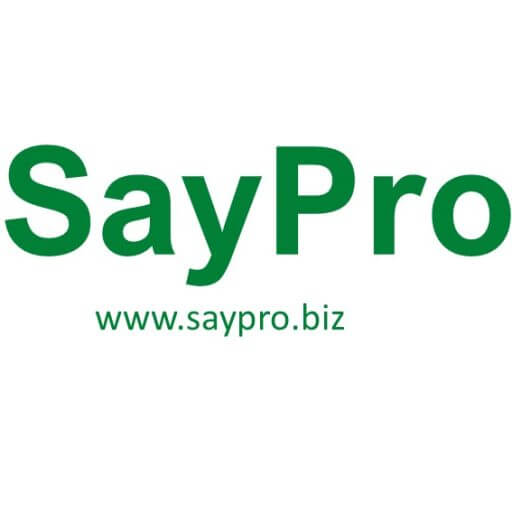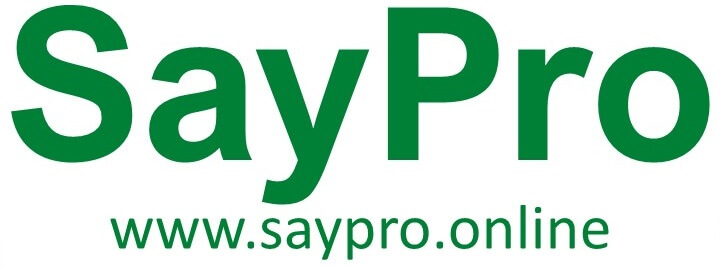Your basket is currently empty!

SayPro: Marketing Social Sharing Training Course
R4 999,00
Description
SayPro: Marketing Social Sharing Training Course
Module 1: Understanding Social Media Platforms
Overview of Major Social Media Platforms
Choosing the Right Platform for Your Business
Analyzing Platform Demographics and User Behavior
Assignment 1: Research Social Media Platforms
Quiz 1: Social Media Platform Basics
Module 2: Creating Engaging Content for Social Media
Types of Content That Drive Engagement
Crafting Compelling Captions and Call-to-Actions
Understanding the Importance of Visual Storytelling
Assignment 2: Create a Social Media Post
Quiz 2: Content Creation Basics
Module 3: Setting Up Social Sharing Tools
Introduction to Social Sharing Plugins and Tools
Integrating Share Buttons on Your Website or Blog
Setting Up Automatic Sharing for New Content
Assignment 3: Install Social Sharing Buttons
Module 4: Optimizing Your Content for Social Sharing
Crafting Shareable Headlines and Tags
Timing Your Posts for Maximum Reach
Assignment 4: Optimize Your Content
Module 5: Strategies for Building Social Media Communities
Engaging with Your Followers and Responding to Comments
Building a Loyal Community Around Your Brand
Leveraging User-Generated Content for Better Social Proof
Assignment 5: Engage with Your Community
Quiz 5: Social Media Community Building
Module 6: Tracking and Analyzing Social Sharing Metrics
Using Analytics Tools to Measure Social Share Performance
Adjusting Strategies Based on Insights
Assignment 6: Analyze Your Social Media Metrics
Quiz 6: Social Media Analytics
Module 7: Paid Advertising for Social Sharing
Introduction to Social Media Ads for Boosting Content
Best Practices for Targeting the Right Audience
Creating Ads that Encourage Sharing and Engagement
Assignment 7: Create a Paid Social Media Ad
Quiz 7: Social Media Advertising
Module 1: Understanding Social Media Platforms
Overview of Major Social Media Platforms
In this module, we will introduce you to the major social media platforms and help you determine which ones are the best fit for your business.
- Facebook: Ideal for creating brand pages, engaging with customers, and running paid ads.
- Instagram: A highly visual platform, perfect for businesses in the fashion, beauty, and lifestyle sectors.
- Twitter: A fast-paced platform great for quick updates, real-time engagement, and trending topics.
- LinkedIn: The go-to platform for B2B marketing and professional networking.
- TikTok: Known for viral content, especially among younger audiences.
Choosing the Right Platform for Your Business
Not all social media platforms will be appropriate for every business. The key is to select platforms based on your target audience and business goals.
- If you have a visually-oriented business, platforms like Instagram or Pinterest are great.
- If your focus is on professional networking, LinkedIn might be your best choice.
Analyzing Platform Demographics and User Behavior
Each platform has unique user demographics. For instance, Facebook has a broad user base across different age groups, while TikTok has a younger audience. Understanding these demographics will help you tailor your content and marketing efforts to the right platform.
Assignment 1: Research Social Media Platforms
- Task: Research and create a list of the social media platforms that are most popular with your target audience.
- Goal: Determine which platforms you should focus on for your social sharing strategy.
Quiz 1: Social Media Platform Basics
- Question 1:Which social media platform is best for B2B marketing?
- A) Instagram
- B) LinkedIn
- C) TikTok
- D) Twitter
- Question 2:Which platform is known for its viral, short-form videos?
- A) Facebook
- B) TikTok
- C) Instagram
- D) LinkedIn
Module 2: Creating Engaging Content for Social Media
Types of Content That Drive Engagement
Creating the right kind of content is key to encouraging social sharing. Here are some types of content that typically drive engagement:
- Infographics: Easy to share and visually appealing.
- Videos: Short, attention-grabbing, and highly shareable.
- Articles/Blogs: High-value content that educates your audience.
- User-Generated Content: Encouraging followers to share their experiences with your product.
Crafting Compelling Captions and Call-to-Actions
Your content should be paired with engaging captions that prompt your audience to take action. A well-crafted call-to-action (CTA) is essential. Examples include:
- “Tag a friend who needs to see this!”
- “Share this post if you agree!”
Understanding the Importance of Visual Storytelling
People are more likely to engage with content that tells a story. Visual content such as photos, videos, and infographics help tell a compelling story that your audience can connect with.
Assignment 2: Create a Social Media Post
- Task: Create a post for one of your chosen platforms (e.g., Instagram, Facebook) with a compelling caption and a call-to-action.
- Goal: Practice crafting engaging content for social sharing.
Quiz 2: Content Creation Basics
- Question 1:What type of content is best for encouraging user engagement?
- A) Text-heavy articles
- B) Infographics and videos
- C) Static images with no caption
- Question 2:What’s an example of an effective call-to-action?
- A) “Like if you agree!”
- B) “Read more on our website”
- C) “Follow us for more updates”
Module 3: Setting Up Social Sharing Tools
Introduction to Social Sharing Plugins and Tools
There are numerous tools available to help you make sharing easy for your audience, such as:
- Social Sharing Plugins: Tools like Add This or Share This allow you to add share buttons to your website.
- Social Media Management Tools: Platforms like Hootsuite or Buffer enable you to schedule posts and track engagement.
Integrating Share Buttons on Your Website or Blog
Having share buttons prominently placed on your website and blog posts encourages visitors to share your content with their networks. Consider placing them at the beginning and end of blog posts.
Setting Up Automatic Sharing for New Content
Many tools allow you to automatically share new blog posts, articles, or products as soon as they are published. Zapier is a popular tool that integrates different platforms for this purpose.
Assignment 3: Install Social Sharing Buttons
- Task: Add social sharing buttons to your website or blog post using a plugin or tool.
- Goal: Make it easy for visitors to share your content on social media.
Quiz 3: Social Sharing Tools
- Question 1:Which of the following tools can help you schedule posts and manage your social media accounts?
- A) Buffer
- B) Google Analytics
- C) Canva
- D) WordPress
- Question 2:What is the purpose of a social sharing plugin?
- A) To track website traffic
- B) To allow visitors to share content on their social media accounts
- C) To create email newsletters
- D) To design social media posts
Module 4: Optimizing Your Content for Social Sharing
Crafting Shareable Headlines and Tags
A catchy headline can make all the difference in whether your content is shared. Use actionable language and make your headlines emotionally engaging.
Timing Your Posts for Maximum Reach
The time you post can affect how many people see and engage with your content. Each social platform has its own optimal posting times, which you should learn and implement.
Using Hashtags Effectively
Hashtags are a great way to increase your visibility on platforms like Instagram and Twitter. Use a mix of popular and niche hashtags relevant to your content.
Assignment 4: Optimize Your Content
- Task: Create a post with a catchy headline, relevant hashtags, and a strong CTA.
- Goal: Learn how to optimize your content for social sharing.
Quiz 4: Content Optimization
- Question 1:Why is it important to post at specific times on social media?
- A) To get more followers
- B) To increase engagement and reach
- C) To reduce the cost of ads
- Question 2:What is the purpose of hashtags on social media?
- A) To make posts look more professional
- B) To categorize content and increase discoverability
- C) To create brand loyalty
Module 5: Strategies for Building Social Media Communities
Engaging with Your Followers and Responding to Comments
Building a social media community is about more than just posting content—it’s about creating conversations and fostering relationships with your followers. Respond to comments, like posts, and engage with users who interact with your content. The more you engage, the more likely your audience will feel connected to your brand.
- Pro Tip: Responding promptly to questions and comments can increase trust and loyalty.
Building a Loyal Community Around Your Brand
A strong social media community is built on trust, consistency, and value. To build this community:
- Share exclusive content that resonates with your followers.
- Host live Q&A sessions or interactive polls.
- Share behind-the-scenes content to humanize your brand.
Leveraging User-Generated Content for Better Social Proof
User-generated content (UGC) refers to content that your followers create, such as photos, reviews, and testimonials. Sharing this content is a powerful way to build trust with your audience, as it shows real people enjoying your product or service.
- Pro Tip: Encourage users to tag your brand in their posts for a chance to be featured on your profile.
Assignment 5: Engage with Your Community
- Task: Respond to comments on one of your recent social media posts and share a piece of user-generated content with credit.
- Goal: Practice building relationships with your followers and enhancing brand loyalty.
Quiz 5: Social Media Community Building
- Question 1:Why is it important to respond to comments and questions on your posts?
- A) To promote your brand
- B) To increase follower engagement and trust
- C) To decrease the reach of your posts
- Question 2:What is user-generated content?
- A) Content you create and post
- B) Content created by your audience and shared with your brand
- C) Content from influencers
Module 6: Tracking and Analyzing Social Sharing Metrics
Using Analytics Tools to Measure Social Share Performance
Once you start sharing content, it’s essential to track its performance to understand what works. Social media platforms like Facebook Insights, Instagram Analytics, and Twitter Analytics provide valuable metrics, such as:
- Engagement rate(likes, comments, shares)
- Reach and impressions(how many people saw your post)
- Click-through rate(how many clicked on links in your post)
Understanding Key Metrics
The key metrics to track for social sharing include:
- Shares: The number of times your content was shared on social media.
- Likes: Indicates the level of engagement with your content.
- Comments: Shows how many users interacted with your post.
- Conversion Rate: How many users clicked through and completed an action (e.g., made a purchase or signed up).
Adjusting Strategies Based on Insights
By analyzing your performance metrics, you can identify which types of content, platforms, and posting times are most effective. Use these insights to refine your social media strategies and improve results over time.
- Pro Tip: If you notice certain content types receive more engagement, consider focusing on those moving forward.
Assignment 6: Analyze Your Social Media Metrics
- Task: Use a social media analytics tool (e.g., Facebook Insights, Instagram Analytics) to track the performance of your recent posts.
- Goal: Gain insight into your content’s performance and identify areas for improvement.
Quiz 6: Social Media Analytics
- Question 1:Which of the following is a key metric to track for social sharing?
- A) Click-through rate
- B) Number of followers
- C) Profile picture size
- Question 2:What can you do with the insights gained from social media analytics?
- A) Ignore them and keep posting the same content
- B) Adjust your strategy to optimize performance
- C) Focus only on the number of shares
Module 7: Paid Advertising for Social Sharing
Introduction to Social Media Ads for Boosting Content
While organic sharing is powerful, paid advertising on social media platforms can significantly amplify your reach and engagement. Platforms like Facebook Ads, Instagram Ads, and LinkedIn Ads allow you to target your audience with precision.
- Pro Tip: Start with a small budget and test different ad types (carousel ads, sponsored posts, etc.) to see what works best.
Best Practices for Targeting the Right Audience
When creating ads, ensure that you target the right audience to maximize engagement and ROI. Some targeting options include:
- Demographics: Age, gender, location, and interests.
- Behaviors: Purchase behavior, device usage, etc.
- Custom Audiences: Upload your email list or website visitors to retarget them.
Creating Ads that Encourage Sharing and Engagement
To create effective ads that people want to share, focus on:
- Creating compelling visuals that catch the eye.
- Using a clear and concise message with a strong CTA (e.g., “Share this offer with a friend!”).
- Incentivizing sharing with contests, giveaways, or discounts.
Assignment 7: Create a Paid Social Media Ad
- Task: Set up a small paid ad campaign on a platform like Facebook or Instagram, targeting a specific audience.
- Goal: Practice creating an ad that encourages sharing and engagement.
Quiz 7: Social Media Advertising
- Question 1:What is the first step in creating a successful paid ad campaign on social media?
- A) Choosing a platform
- B) Selecting a target audience
- C) Designing the visual assets
- Question 2:Which of the following is an effective strategy for getting users to share your paid ad?
- A) Creating an ad with a clear call-to-action
- B) Using a generic image with no text
- C) Ignoring your target audience’s interests
You must be logged in to post a review.
Vendor Information
- No ratings found yet!
-
SayPro :Marketing Social Media Links Training Course
R4 999,00 Add to basket -
SayPro :Marketing Security Training Course
R5 999,00 Add to basket -
SayPro: Marketing Data Backup Training Course
R3 999,00 Add to basket -
SayPro :Marketing Disaster Recovery Training Course
R5 999,00 Add to basket -
SayPro :Marketing Help Desk Training Course
R6 999,00 Add to basket -
SayPro: Marketing Email Marketing Training Course
R5 999,00 Add to basket














Reviews
There are no reviews yet.